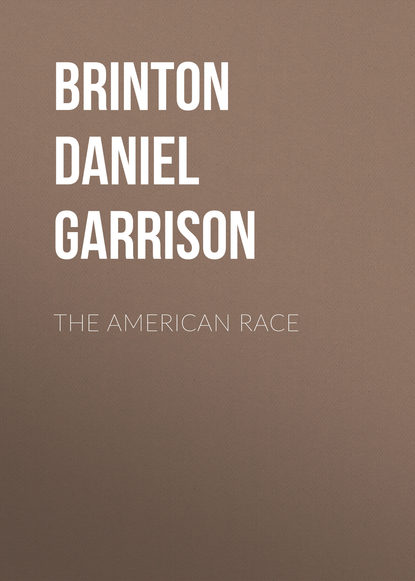 Полная версия
Полная версияThe American Race
A singular question has arisen as to the relationship of the Betoya and the Yarura languages. Their near connection was affirmed by the early missionaries. In fact, the history of the conversion of the Betoyas turns upon the identity of the two tongues. It was brought about in 1701 by a Yarura Indian, a convert to Christianity, who accidentally discovered that he was understood by the Betoyas.
In spite of this detail, it is evident from an inspection of the vocabularies, that there is absolutely no relationship between the two idioms. I can only explain the contradiction as arising from some ambiguity or similarity of names. The two tribes lived together in the time of Gumilla, making up about three thousand souls.424
About the middle of this century some six hundred of the Betoyas dwelt on the head-waters of the river Manacacia.425
In the territory of St. Martin, above the falls of the Guaviare and along the Rio Guejar and the Meta, are several tribes asserted to speak related dialects, but of which I have little information. The principal one is that of the Churoyas, of whom Professor Nicolas Saenz has given an interesting sketch and a short vocabulary.426 They are very ugly, with broad faces, low foreheads, small and oblique eyes, and in color like dried tobacco. Nudity is their usual garb, and the skin is decorated with tattoo marks instead of clothing. According to Perez they number about 1200.427 Following him and other authorities, I may enumerate the following members of the
CHUROYA LINGUISTIC STOCKBisaniguas, on the Rio Guejar.
Choroyas, on the Rio Guejar.
Cofanes, on the Rio Aguarico.
Guayues, on the Rio Caqueta.
Macos, on the Rio Aguarico.
Whether the Cofanes here named are those of the Province of Quitu who murdered the Jesuit missionary, Raphael Ferrer, in 1602, I have not discovered. Perez describes them as still warlike and seclusive, living in the terminal hills of the Cordillera, and avoiding traffic with the tribes of the lower river.428
An examination of the vocabulary furnished by Saenz inclines me to think that the Churoya may be a mongrel dialect, or at least has borrowed freely from neighboring stocks. I subjoin the principal words from his short vocabulary, with some comparisons:
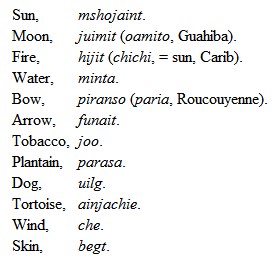
The Piaroas are mentioned by Gilii as a branch of the Salivas, but their language reveals no such connection. They are still found on both banks of the Orinoco above the confluence of the Vichada and near the mouth of the Mataveni. They are savage and superstitious, avoiding contact with the whites; they have had good reason to be extremely distrustful of the advances of their civilized neighbors. They are much given to nocturnal ceremonies, and entertain a great respect for the tapir, who is their reputed ancestor, and also the form which is taken by the souls of the departed.429
The Puinavis dwell on the Inirida, an affluent of the Guaviare. A tribe, the Guipunabis, is mentioned by Gilii as belonging to the Maipure (Arawak) stock; but it cannot be the same with the one under consideration, the language of which appears to be without affinities. Latham identified them with the Poignavis of the older writers, and on slight linguistic evidence, believed them connected with the Banivas.430 My own comparisons do not justify this opinion.
8. The Upper Amazonian Basin
No portion of the linguistic field of South America offers greater confusion than that of the western Amazonian region. The statements are so conflicting, and the tribal changes apparently so rapid, that we are at a loss to bring modern observations into accord with older statements. Thus, I am entirely unable to accept the linguistic classification of Hervas, which certainly was based on the best information of his day. As a matter of comparison I give it.
List of Languages in the Governments of Maynas and the Marañon (Hervas).
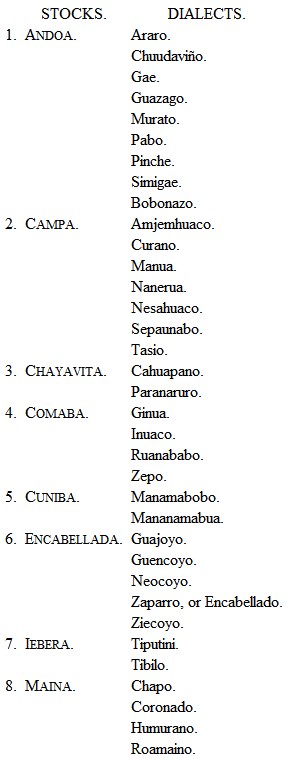

A slight examination of this classification suffices to reveal its general inaccuracy. The Zaparos are included in both the Encabellada and the Simigae stocks. The latter is given both as a stock and as a dialect of the Andoa. In fact, all three of the stocks named belong together as dialects of one. The Pano stock, as we now know it, appears scattered under Cuniba, Urarina and Pana; and the arrangement is incorrect in many other points. While it has a value in preserving the names of some now missing tribes, as a linguistic scheme it is wholly unsafe.
The Zaparos constitute one of the most extended and numerous nations in the upper valley of the Amazon. They dwell near or adjacent to the Jivaros on the south, and as their name is variously spelled Zaparos, Xeberos and Jeberos, they have at times been confounded with them. They differ, however, not only in language, but in appearance and temperament. The Zaparos are lighter in color, smaller in stature, with oblique eyes, large mouths, and expanded nostrils.431 Their disposition is indolent and easy tempered, and their abilities inferior. This is seen in the construction of their houses and the appearance of their fields, which do not compare advantageously with those of the Jivaros; but they display some ingenuity in manufacturing clothing from the bark of a species of Ochroma, and they are skillful in concocting the urara poison, in making blow-pipes, and are daring boatmen.
In 1632 they lived near the Omaguas, on the river Curary, and their number was estimated by the missionaries at 10,000. At present their main body dwells between the rivers Pastaza and Napo and along the Marañon between the rivers Zamora and Morona. In 1850 Osculati estimated their number at over 20,000, which is certainly in excess of their present representatives. The many small tribes into which they are divided, and the confused orthography of the names applied to them, render it difficult to offer a satisfactory list. It seems tolerably certain that the ancient “Andoas” were the Zaparos of the upper Pastaza,432 and equally sure that the Encabellada, the Iebera, the Simigae and the Jinori languages, all supposed by Hervas to be independent stocks,433 were spoken by members of the Zaparo family. The Iquitos are another populous branch, sometimes supposed to be distinct.
The Zaparo language is agreeable to the ear, partaking of the phonetic character of the Brazilian idioms. The Italian traveler, Osculati, has furnished a very satisfactory account of it, both grammatical and lexicographical,434 and there are vocabularies by other voyagers.
I offer the following alphabetic list of the sub-tribes of the Zaparos, without attempting to define their several positions in the general district referred to:
ZAPARO LINGUISTIC STOCKAchuales.
Agapicos.
Aicores.
Andoas.
Anguteris.
Antires.
Araros, or Arazos.
Ayacares.
Bobonazos.
Cahuaches.
Chudavinos.
Churitunas.
Comacoris.
Conejoris.
Copatasas.
Curyies.
Curarayes.
Custimanos.
Cutinanas.
Encabellados.
Eriteynes.
Frascavinos.
Gaes.
Ginoris.
Gualaquizas.
Guazacas.
Himuetacas.
Huasimoas.
Ibanomas.
Incuris.
Itremajoris.
Macavinas.
Mautas.
Moronas.
Mueganos.
Muratos.
Napotoas.
Neocoyos.
Nepas.
Nerecamues.
Nushinis.
Oas.
Panajoris.
Paranapuras.
Pastazas.
Pavos.
Pindis.
Putumayos.
Quirivinas.
Rotunos.
Semigaes.
Shiripunas.
Tabalosos.
Tiputinis.
Tivilos.
Tremajoris.
Yasunis.
Yegueyos.
Yetes.
Zamoros.
Zapaos.
On the mountain slope of the Cordillera, north of the Zaparos and east of the Cañaris, are the Jivaros (Givaros, Xivaros), a wild, warlike tribe, never subjugated either by the Kechuas or the Spaniards. Their homes are about the head-waters of the rivers Pastaza, Santiago, and other affluents of the Marañon. They are rather tall, of light color, with thin lips, aquiline noses, straight eyes, prognathic jaws, hair black or with a reddish tinge.
Some say their various bands number as many as four hundred, named from the streams on which they live. Most of them depend upon hunting and fishing, others pursue agriculture and breed pigs. Their weapons are the sarbacane, the lance, the bow and the shield. They have developed a system of sound-signalling or telegraphy by means of large wooden drums placed at certain distances apart, by beating on which in a peculiar manner the advent of an enemy, his number and direction, can be heralded over hundreds of square miles in a few hours. The Jivaros are celebrated for the preparation of human heads by a process of boiling and drying so as to preserve the hair and soft parts. Many of these trophy heads have been brought to Europe, and their purpose has led to some discussion. It appears that they are prepared both as trophies of victory and out of reverence to departed chiefs.435 Their houses are built solidly of wood, with wooden doors. They sleep upon wooden frames, and construct tools of the same material.436
The principal event in their history was their revolt against the Spanish authorities in the year 1599. They destroyed many settlements and the entire city of Logroño, carrying the women into captivity. Many of them had already been converted to Christianity, and their rites are said still to preserve some reminiscences of such teachings. In recent years many of them have been civilized through the efforts of Italian missionaries.
The language of this important nation, although early studied, has as yet no printed literature. I have found of it only the first five numerals, which do not seem to have connection with any other tongue. They are as follows:
1. Alza; 2. catuta; 3. kala; 4. ingatu; 5. aleyticlon.437
From a study of proper names and ethnographic traits, Dr. Hamy has expressed himself with great assurance that the Jivaros belong to the Guarani group of the Tupi stock;438 but the above numerals do not indicate such relationship, nor do I think that his other arguments establish it. For the present they must be considered an independent stock.
JIVARO LINGUISTIC STOCKAntipas, above the Pongo de Manseriche.
Aguarunas, below the mouth of the Rio Nieva and Rio Huallaga.
Ayulis, on the Rio Morono.
Cherembos, left bank of Marañon.
Chirapas.
Huambisas, on Marañon above the Pongo de Manseriche.
Lojanos.
Muratos, below mouth of the Rio Pastaza.
Pautis.
Uambisas, south of the Marañon.
Zamoras.
The eastern neighbors of the Jivaros are the scattered bands of the Maynas, separated by Hervas into two stocks, the Maina and the Chayavita, but so far as I can learn, without sufficient reason. The language is or was spoken at the mission of the Conception on the upper Marañon and in the uplands around Cerros de Mainas. It is singularly harsh and difficult. The natives were wild, and lived by hunting and fishing. Their earlier home was on the upper waters of the Morona and Pastaza rivers.
The following bands are embraced in the
MAINA LINGUISTIC STOCK. 439Cahuapanas.
Chapos.
Chayavitas.
Coronados.
Humuranos.
Mainas.
Roamainas.
On the Rio Javary there seem to be several independent stocks. One of these is that of the Yameos, who are found in the lower course of the river and also further up the Marañon, near Nauta, and on the Huallaga, where they are called Llameos, Yameos, Lamas, or Lamistas. Formerly they were a numerous and warlike nation, sharply divided into gentile organizations, and carefully refraining from intermarriage in the gens. At an early date we hear of them between the Rio Tigre and the Napo. (Markham.)
The following sub-tribes are stated by various writers to belong to the
LAMA LINGUISTIC STOCKAguanos.
Alabonos.
Amaonos.
Cahuaches.
Massamaes.
Miquianos.
Nahuapos.
Napeanos.
Parranos.
Yarrapos.
Pöppig describes them as agricultural and industrious, and much given to trade and travel.
In appearance, they are small, dirty and Mongoloid, sharply contrasting with the Indians of the Huallaga, who are all tall, strong and well built, with good features.440
In conformity to old authorities, Markham classes the Ardas as a sub-tribe of the Yameos. Their home was between the rivers Napo and Masso. On the latter they were in immediate contiguity to the Massamaes (Coleti). There has been published a Doctrina in their language, from which the Lord’s Prayer is quoted by Ludewig.441 This version has no resemblance to the Pater in Yamea contained in the Mithridates; so for the present I leave the Ardas unclassified.
Higher up the river Javary are a number of tribes speaking related dialects of what I shall call the Peba stock, though there are some reasons to consider it a corrupt dialect of the Omagua, and hence related to the Tupi.
PEBA LINGUISTIC STOCKCaumaris.
Cauwachis.
Pacayas.
Pebas.
To this list I add the Yeguas, Yaguas or Yahuas, found in the same vicinity, and remarkable for their fine personal appearance, “the most perfect physical type,” says M. Ordinaire, “of all the Indian races.”442 The vocabulary of their language obtained by Castelnau shows unmistakable affinities to that of the Pebas.443
On the Rio Chambira, adjacent to the Yameos and Omaguas, dwelt in the early part of the last century the Itucales and Varinas or Uarunas, who, according to Coleti, spoke allied dialects. The Itucales were noteworthy as the aptest and most biddable converts obtained by the missionaries on the river. They were agricultural and monogamous.444 Hervas classes them with the Musimos, the Mayorunas and the Barbudos, under the Urarina language; but the last two are members of the Pano stock.
The Ticunas (Tecunas, Tucunas) are found along the lower Javary and the Solimoes, adjacent to the Pebas. They wander about in a state of nakedness, depending on hunting and fishing, and under a loose control of the Brazilian government. Many of them can converse in Kechua, though their own tongue is of a different group. They are given to dances of a sacred character, in which the actors appear in masks. An operation allied to circumcision is practiced on infants of both sexes at the time of assigning them names.445 One of the several tribes called “Orejones” is thought by Pöppig to belong to the Ticunas.446
The tribes in the valley of the Huallaga were first visited by Franciscan missionaries in 1676. In that year Father Jose de Araujo converted a number of the Hibitos (Xibitos) in the Upper Huallaga, and wrote an arte of their language. He found it the same as that of the Chunchos in the Sierra. Their neighbors further down the river, the Cholones, speaking a different idiom, were brought under the instruction of Father Francisco Gutierrez, who composed a work on their tongue. A century later we find these two nations living together at the mission, counting 4800 souls, and occupying that portion of the province of Cajamarquilla between 7° and 8° 30´ s. lat. They were peaceable and agricultural, with fields of cotton and food plants.447
This fair scene disappeared in the turbulent life of the next generation, and when the traveler Pöppig visited the Huallaga in 1834 he found the mission in decay, and the natives, much reduced in numbers, had resumed their wild life and again become savages.448 At present, along the main stream to the north, are the Cocamillas, the Aguanteas, and the Puinahuas. All these appear to be of the Tupi stock, with dialects akin to the Cocama and Omagua.449
The Panos. When the missionaries first crossed the Cordillera and explored the upper Ucayali river, they found a number of related tribes, the principal of whom were the Panos. By their traditions they had moved from near the equator at the north. They differed little in culture from their neighbors, and are now nearly extinct. By the earlier writers they were placed in relation to the Omaguas as members of the Tupi stock,450 but the researches of M. Raoul de la Grasserie have vindicated for them an independent position.451 They are said to have possessed a form of hieroglyphic writing, which they painted on a sort of paper manufactured from vegetable fibre.
Some of the Mayorunas are reported as having thick beards and white skins (Martius), but these peculiarities are probably attributable to early admixtures with the white race.
The largest of these tribes at present is that of the Conibos, who constitute now the greater part of the natives the traveler encounters on the Ucayali. In appearance they have some resemblance to the Peruvians. The nose is aquiline and prominent, the forehead broad, the eye large, and the cheek bones not prominent. In intelligence they are superior to their neighbors, learning the Spanish language readily, and proving themselves valuable house-servants. They are apathetic, however, and none of the Panos have shown any earnest desire to adopt a civilized life.452
The Cashibos are the most savage tribe on the Ucayali or its affluents, and are said to have the ugly custom of eating their relations when they die, and if this event is long delayed, the old men are killed. But such is the power of ideas, that one of the obstacles to their conversion is that they so much prefer their bodies to become food for their relatives than a feast for worms!453
The Pacaguaras or Pacavaras, on the rivers Beni and Mamore, classed by D’Orbigny as a separate stock, belong among the Panos, as is clearly seen by the vocabulary furnished by that traveler, and later that by Mr. Heath.454 The easternmost branch of the stock (not noted by M. de la Grasserie), are the Canawarys (Canamarys), who live on the banks of the Purus. Mr. Chandless heard that they were related to the Conibos, and the few words he obtained of their language prove the statement correct.455

Mr. Chandless also says, “The Conibos are of the same tribe as the Manitenerys of the river Purus,” which would bring these latter also into the Pano stock. The short vocabulary of their language which he supplies does not bear out this assertion. Mr. Richard Spruce considered that it proved them to be of the Carib stock;456 but to me it seems unmistakably a member of the Arawak family, as will be seen from the following analysis:
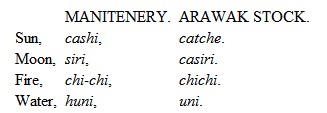
From the above considerations I offer the following names as comprising the
PANO LINGUISTIC STOCKBarbudos, on the Marañon.
Callisecas, on upper Ucayali.457
Canawarys, on Rio Purus.
Caripunas, near cataracts of Rio Madeira.
Cashibos, on Rio Pachitea and Aguaitia.
Chamicuros, on west bank of the Rio Huallaga.458
Cochivuinas, a sub-tribe of Mayorunas.
Conibos, on upper Ucayali.
Culinos, on Rio Juvary.
Jaunavos, see Caripunas.
Mayorunas, on Rio Tapichi and Rio Yavari.
Maxorunas, near Rio Tapichi.
Panos, on upper Ucayali.
Pacaguaras, on Rio Beni.
Remos, on Ucayali, from Abayan to Chanchaguaya.
Sencis, right bank of Ucayali above Saraycu.
Setibos (Setevos), on upper Ucayali.459
Sipibos, on upper Ucayali.
Mr. Chandless460 met on the rivers Purus and Jurua tribes of a stock whose tongue I have not been able to connect with any other. They are represented on the former stream by the Pammanas or Pammarys (pama-ouiri, eaters of the pama, a kind of berry), or Puru-purus (piru-poru, name of a skin disease which prevails there), whose name has been transferred to the river. These are believed by Martius to be the same or allied to the Pamas, a tribe who formerly lived on the Madeira, but were driven thence by the Caripunas.461 On the Jurua are the apparently related Arauas and Araicus. All these depend on hunting and fishing, and are of migratory habits. Some of the Pammanas are reported as light in hue, with blue eyes and brown hair.462
Many tribes with names differing from the above are recorded by the older writers as resident on these rivers, but owing to the absence of linguistic material, no identification is possible.
The close relationship of the Pammarys of the Purus and the Arauas of the Jurua is shown by the following comparison:
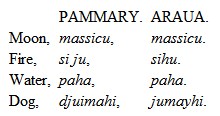
So far as known, I would place the following tribes in the
ARAUA LINGUISTIC STOCKArauas (Araó), on the lower Jurua.
Pamas, formerly on the Madeira.
Pammarys, on the Rio Purus.
Puru-purus, on the Rio Purus.
The jargon of the Yaguas, on the Amazon between Nauta and Pebas, seems to have borrowed from this stock; as:

The neighbors of the Arauas on the river Purus are the Hypurinas (better Jupurinas) of whose language Mr. Chandless also supplies a short vocabulary. It contains a few words in common with the Pammary, but probably only borrowed by both from the Arawak. The following will illustrate the two tongues:

The Hypurinas on the Rio Acre (or Aquiri) belong to the same tribe. They are said to be related to the Chacobos and the Piros of the Ucayali. They are without civilization. The women go naked, but the men wear long purple robes, and both sexes pierce the lips and nose. Some agriculture is carried on, but hunting and fishing are the main sources of the food supply.463
The total number of natives on the Purus and its affluents was estimated by Colonel Labré, in 1885, at 40,000, “speaking forty or more different languages;” but this last assertion we may take with large allowance. Probably not over four or five stocks are represented. The same explorer names nine tribes visited by him on the river Ituxy. They are the: 1, Caccharari; 2, Canamary; 3, Catauxi; 4, Guarayo; 5, Huatanary; 6, Hypurina; 7, Hyuma; 8, Pamana; and 9, Pammary tribes.464
In this list, as elsewhere, the term Guarayos has no ethnic significance. It is a Tupi word applied in this Spanish form to various wild, uncivilized tribes.
9. The Bolivian Highlands: the Chiquitos, Yurucares, Mosetenas, Tacanas, Samucus, Canichanas and others
On the Atlantic face of the Cordillera, in the easternmost portion of Bolivia, where the head-waters of the Madeira are known by the names of the Mamore, the Guapai and the Beni, there is an astonishing variety of linguistic stocks. It would seem that the broken remnants of many diverse nations had sought refuge in the deep vales and dense forests of this region.



